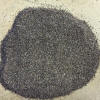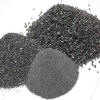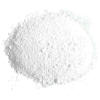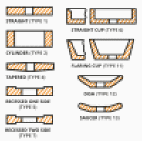In a grinding wheel, the abrasive performs the same function as the teeth in a saw. But unlike a saw, which has teeth only on its edge, the grinding wheel has abrasive grains distributed throughout the wheel. Thousands of these hard, tough grains move against the workpiece to cut away tiny chips of material.
The particular abrasive used in a wheel is chosen based on the way it will interact with the work material. The ideal abrasive has the ability to stay sharp with minimal point dulling. When dulling begins, the abrasive fractures, creating new cutting points.
Each abrasive type is unique with distinct properties for hardness, strength, fracture toughness and resistance to impact.
Aluminium oxide is the most common abrasive used in grinding wheels. It is usually the abrasive chosen for grinding carbon steel, alloy steel, high speed steel, annealed malleable iron, wrought iron, and bronzes and similar metals. There are many different types of aluminium oxide abrasives, each specially made and blended for particular types of grinding jobs. Each abrasive type carries its own designation-usually a combination of a letter and a number. These designations vary by manufacturer.
Zirconium alumina is another family of abrasives, each one made from a different percentage of aluminium oxide and zirconium oxide. The combination results in a tough, durable abrasive that works well in rough grinding applications, such as cut-off operations, on a broad range of steels and steel alloys. As with aluminium oxide, there are several different types of zirconium alumina from which to choose.
Silicon carbide is an abrasive used for grinding gray iron, chilled iron, brass, soft bronze and aluminium, as well as stone, rubber and other non-ferrous materials.
Ceramic aluminium oxide is the newest major development in abrasives. This is a high-purity grain manufactured in a gel sintering process. The result is an abrasive with the ability to fracture at a controlled rate at the sub-micron level, constantly creating thousands of new cutting points. This abrasive is exceptionally hard and strong. It is primarily used for precision grinding in demanding applications on steels and alloys that are the most difficult to grind. The abrasive is normally blended in various percentages with other abrasives to optimize its performance for different applications and materials.
 |
 |
 |
|
| Aluminium oxide | Aluminium oxide | Silicon carbide | Silicon carbide grains |
 |
 |
 |
 |
| Zirconium alumina | Zirconium alumina | Ceramic aluminium oxide | Ceramic aluminium oxide |
 |
 |
 |
Rubber bond (R):
- Rubber-bonded wheels are extremely tough and strong.
- Their principal uses are as thin cut-off wheels and driving wheels in centre less grinding machines.
- They are used also when extremely fine finishes are required on bearing surfaces.
- This bonding material is used when the heat generated by grinding must be kept to a minimum.
- Silicate bonding material releases the abrasive grains more readily than other types of bonding agents.
- This is the softest bond in grinding wheel.
- Sodium silicate is used as binding material for grinding wheels
- Vitrified bonds are used on more than 75 per cent of all grinding wheels.
- Vitrified bond material is comprised of finely ground clay and fluxes with which the abrasive is thoroughly mixed.
- Resinoid bonded grinding wheels are second in popularity to vitrified wheels.
- The phenolic resin in powdered or liquid form is mixed with the abrasive grains in a form and cured at about 360F.
- It's an organic bond used for grinding wheels that produce very smooth finishes on parts such as rolls, cutlery, camshafts and crankpins.
- Generally, they are not used on heavy-duty grinding operations
- Metal bonds are used primarily as binding agents for diamond abrasives.
- They are also used in electrolytic grinding where the bond must be electrically conductive
The type you use is dependent on the task at hand or the desired finish. Below are some of the more common shapes of grinding wheels in use today:


